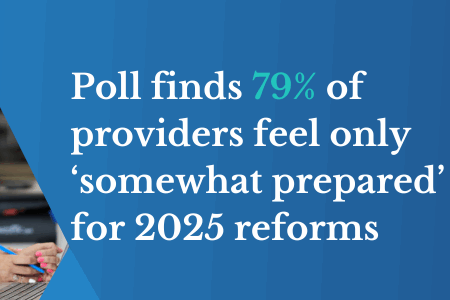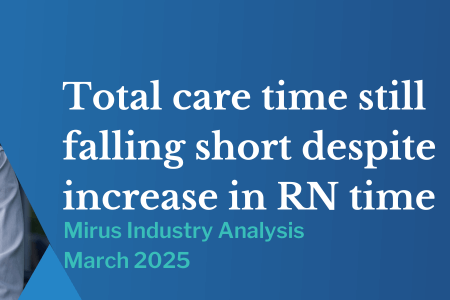Is now the time to change your rostering platform?
July 11, 2023 | Data

By Shannon Sanderson, Head of Sales
Few would argue that workforce isn’t the biggest issue in residential aged care.
The requirements of a 24/7 RN have commenced last week and the introduction of mandatory care minutes on October 1 is now less than 3 months away. In fact, we are already in the measurement period that will be used to calculate those mandatory minute targets.
Workforce is also the largest cost for residential aged care and the Department of Health and Aged Care (DoHAC) estimates providers will need to spend around 75% of their AN-ACC funding on staff who contribute to care minutes (RNs, ENs and Care workers). These percentages will put pressure on margins as a greater proportion of funding is diverted towards care minutes under AN-ACC than ACFI.
A strong workforce management strategy therefore needs to include cost management strategies. When you consider the industry changes, monthly and quarterly reporting requirements and pressures on financial sustainability it becomes clear that now is the time to ensure your workforce software is helping rather than hindering.
This is an area that we have extensive knowledge in having built our own rostering platform Mirus Works in 2016. Providers across Australia are using Mirus Works to meet their rostering, care minute management, award interpretation, time and attendance, shift offer and Quarterly Financial Reporting (QFR) needs or alternatively they are using it to provide care minute management not currently available in their existing rostering platform.
The 3 key factors we built Into Mirus Works are:
- Co-design with industry and clients – Our current functionality and future roadmap are designed with our Australian aged care clients’ needs in mind because the Australian care sector is the only one that we operate in.
- Access to real time data – We include integrations with Medicare and inbuilt award interpretation into Mirus Works so our clients have the data they need on facility scenario and costs in real time to make informed decisions (because this is where most cost is lost in rostering).
- Great user experience – Our team focusses on human centred design. Mirus Works delivers clear workflows, intuitive design, and presentation of information on each screen so that your staff can easily perform the tasks they need to. Usability is one of our top differentiators and it becomes clear as soon as someone touches the system.
Here are 5 questions to consider when reviewing your workforce software and how we built Mirus Works to address them.
1. Are you using forward or rear-view thinking when managing your care minute requirements?
Care minute management is more than reporting. It is important to have a view of how you are tracking during the period when you have an opportunity to make changes rather than find out you haven’t met your care minute target at the time you are preparing the quarterly financial report.
Mirus Works allows you to plan, track and report on a facility’s care minutes taking the shock out of preparing your QFR.
Plan: Configure roster demand templates to meet your care minute requirement
Track: Monitor care minute compliance during the roster period and quarter
Report: QFR specific reports included in our suite of reports
It is important to note that Mirus Works tracks care minutes not staff ratios per the industry requirements from the Royal Commission. Care minutes are a case mix driven allocation taken from the care needs of your residents from the previous quarter.
It is also important to have your care minute processes documented. This could be a policy or guidance tool but would include the job titles at your organisation that are included in care minute calculation and how hybrid roles are allocated. We are working with several providers to develop or review these policies – please reach out if you would like some assistance.
2. Are your staff fully utilised?
If a staff member is contracted for 38 hours a week, does your rostering team ensuring they are rostered to their 38 hours before they fill vacant shifts elsewhere?
Staff shortages make the task of filling vacant shifts difficult enough and calling on staff who always accept additional shifts or a reliable agency would be a quick fix. However, without a process of ensuring all employee contracted hours are fully met you could be sending another staff member into overtime and engaging casual or agency staff unnecessarily.
This is a challenge often raised by clients and requires clear visibility of the hours staff are rostered and their contracted hours. Ideally staff who are not permanently rostered to their contracted hours should be visible at the time the roster is created and when filling vacant shifts.
Mirus Works clearly identifies your staff’s rostered versus contracted hours when rostering and filling vacant shifts. This gives your team the ability to fill contracted hours before incurring the cost of casual or agency staff.
3. When do you know the cost of your roster?
If you don’t know the cost of the roster until after shifts have been worked or paid you have no ability to control your biggest expense in residential aged care. Without real time data this is exactly what Roster Coordinators are doing. By giving them access to real time data they can understand the financial implications of rostering decisions. For example, is offering a part time staff member an additional shift a better decision than offering this to a casual staff member? These decisions can vary based on staff available and their pay grade so having this available per shift can substantially impact your bottom line.
By including inbuilt award interpretation in Mirus Works and the real time data it provides, your staff have the information they need to make faster decisions and can see the impact of overtime, or use of casual and agency staff for every single shift – not just those relating to care minutes.
4. Is your shift offer process as efficient as it could be?
Does this sound familiar? Nurse Jenny goes into overtime each month which is frustrating for the finance team. However, the Roster Coordinator knows that Jenny will always say yes to picking up additional shifts especially at short notice. By giving your Roster Coordinator a more efficient process to offer vacant shifts, the reliance on staff like Jenny reduces and so does your overtime costs.
Shift offer capability should be inbuilt into your roster with real-time visibility of available staff and direct communication specifically to those staff who meet the shift designation and skills. If your system is sending all shift offers out to all staff, you are risking staff completely ignoring the communications or rostering staff not using the function because of its lack of effectiveness.
The ability to exclude staff without current mandatory requirements (e.g., registration or vaccinations) and visibility of the financial implications is key to reducing risk and cost blow out. Once again the importance of real time data will streamline the process.
Mirus Works inbuilt shift offer functionality gives your team the ability to offer shifts straight from the roster with real-time visibility of available staff, costs per staff member and their current rostered versus contracted hours. Shift offers can be sent to one or multiple staff with direct communication to the staff app. Accepted shifts are automatically updated in the roster meaning reduction in manual processes.
5. How are you reducing compliance risk?
Aged care is a compliance driven business and HR is an area of significant risk. This makes rostering in residential aged care a minefield for potential risk exposure. Your rostering software should provide you with the ability to exclude staff from the roster who are in breach of key requirements at an organisation, facility, and shift level. These can include vaccination, visa, skills, and registrations.
Mirus Works Roster Rules functionality supports management of award interpretation and industrial compliance alerts.
Roster Rules will either prevent a person being rostered or provide an alert when a specific roster rule has been broken. This is configurable according to client requirements.
Situations where Roster Rules can be implemented include:
- Award or EBA requirements (for example shift breaks or number of shifts in a row)
- Skills/training records in line with your education policy
- Vaccinations
- Registrations
- Visas and hour restrictions
If any of these questions sound like challenges you are facing, please reach out to Mirus. We would be happy to introduce you to Mirus Works, our comprehensive rostering software tool which helps reduce unplanned overtime wage costs, saves you time managing rosters and enables a more engaged, more connected workforce.


